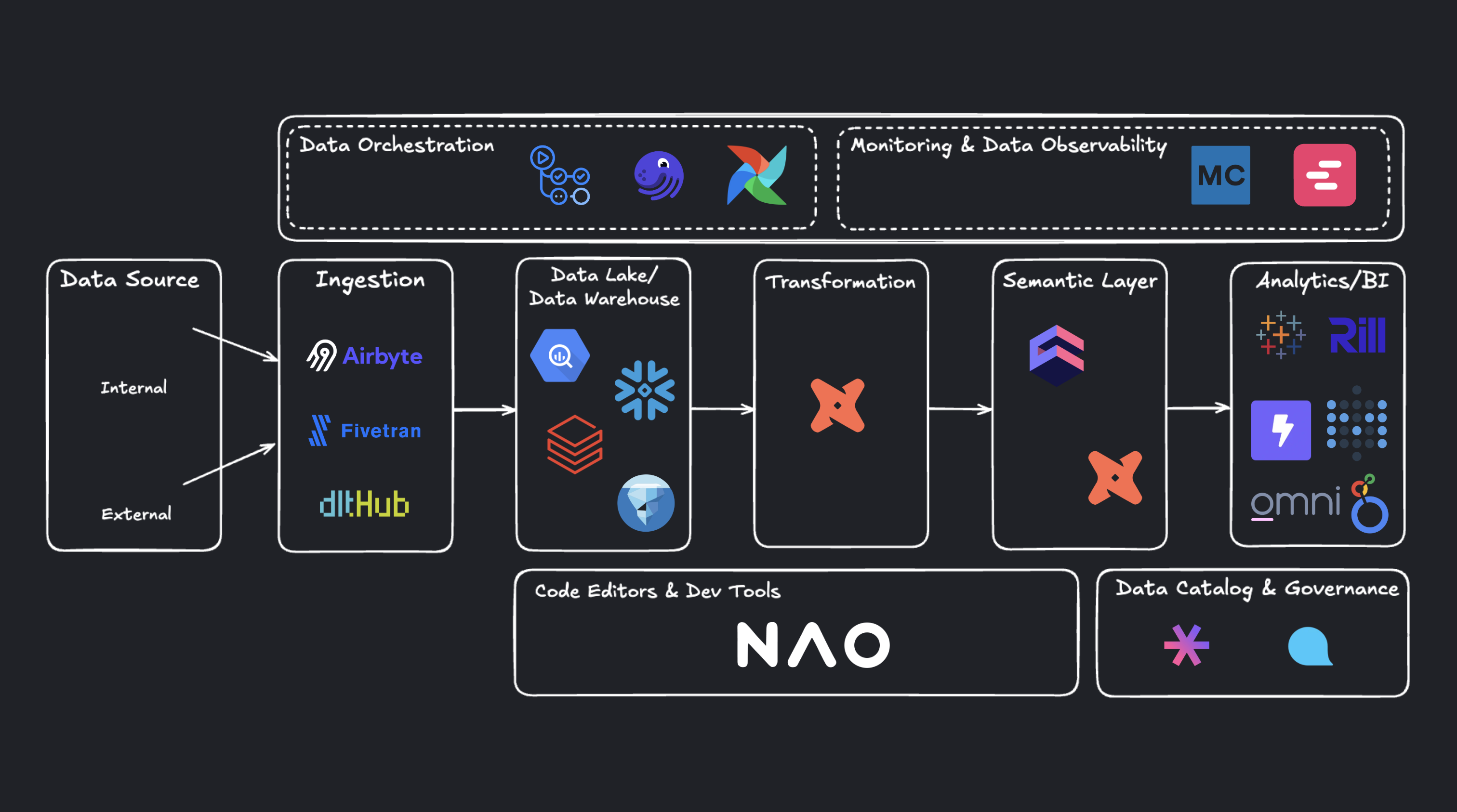How to choose the right data stack
Table of contents
Why the Modern Data Stack?
The Modern Data Stack (MDS) is a new, cloud-first way to work with data. Unlike old systems that were big and monolithic, it's modular - you pick the tools you need for collecting, transforming, and analyzing data.
If your data is mainly in the cloud, available through your internal data sources or via APIs for external data, the Modern Data Stack can help you move faster, scale easily, and plug in AI tools as you grow.
This guide walks you through the main components of a Modern Data Stack and helps you choose the right setup for your company's stage and data maturity.
The Core Components of a Modern Data Stack
At a high level, the core components of a Modern Data Stack follow the data processing flow: ingestion, transformation, and exposure.
The following diagram illustrates this lifecycle and the different building blocks of the stack:

How to Assemble Your Data Stack
There's no one-size-fits-all Modern Data Stack. The right setup depends on your company size, data maturity, and AI ambitions.
The key is to start simple, then grow modularly as your data capabilities evolve.
1. Starter Stage (early-stage startup)
Focus on the essentials: a warehouse, transformation layer, and BI tool. Use the AI data editor nao to speed up your development cycles.
This setup gives you reliable data flows without heavy infrastructure.

2. Scaling Stage
As data volume and team size increase, introduce orchestration, monitoring, and self-serve BI. These layers bring reliability, automation, and accessibility, ensuring your stack scales smoothly.

BI tools Omni and Lightdash sit on top of dbt, providing a semantic layer that ensures consistent metrics and version control, and scale smoothly with your dbt project and data stack.
Data observability tool Elementary is dbt-native and monitors dbt models with automated tests and quality metrics, while enterprise-grade Monte Carlo tracks pipelines end-to-end, detects anomalies, and alerts teams to keep data reliable.
3. Mid-Enterprise Stage
At this stage, focus on consistency, governance, and collaboration. Add a semantic layer to standardize business definitions, and include data catalog and governance tools to maintain data quality and compliance. As data volumes grow, enterprises can also move from a data warehouse to a data lake to handle large, diverse datasets.

4. Data as Code (DaC) Stack
If you want to fully mange your stack as code - and make it easier for AI agents to manage it for you, you can move to code-based configurations, defining pipelines and transformations directly in code instead of manual clicks.
This gives you more control, automation, and versioning, making your workflows faster, reproducible, and AI-ready.

Conclusion
The right data stack depends on your company's size, data maturity, and long-term goals.
- Begin with the core building blocks - warehouse, transformation, BI.
- Add orchestration, observability, semantic layers, and cataloging as you scale.
- Focus on fit and workflow, not trends or tool popularity.
- And remember, AI data editor nao can automate setup and workflows so data teams spend more time on insights - not maintenance.
A well-designed data stack grows with you - simple at the start, powerful as you evolve.
Frequently Asked Questions
What is the Modern Data Stack?
A modular, cloud-based system for collecting, transforming, and analyzing data - faster, simpler, and more flexible than traditional pipelines.
Why does it matter for AI?
It gives AI models clean, reliable, and structured data - the foundation for accurate insights and automation.
What are the best AI tools to work with the Modern Data Stack?
nao is one of the best AI copilots for modern data teams. It helps you build pipelines, write SQL, create dbt models, and document workflows automatically.
What are the best AI tools to work on dbt?
nao integrates natively with dbt Core - it can generate models, YAML files, and documentation from natural language, and automate commits and tests.
What is "Data as Code"?
It's the practice of defining your data stack and transformations directly in code (e.g., YAML or SQL) for versioning, automation, and reproducibility.
How can I manage my stack "as code"?
Use open-source tools like dlt, dbt Core, and Lightdash - or automate everything with nao, which handles configuration and setup through natural language prompts.
How can AI speed up data workflows?
AI can automate repetitive tasks like creating models, writing queries, and maintaining pipelines. With nao, you can do all this locally through a single AI interface.
Does nao connect to warehouses like Snowflake or BigQuery?
Yes - nao connects to major warehouses (Snowflake, BigQuery, Redshift, Postgres, DuckDB) to query data, build dbt models, and orchestrate pipelines.
nao team
